TURKEY'S MAGICAL HIDEAWAYS
May 22 - June 7, 2009
Page One
Istanbul
Very Condensed History of Turkey
More than 70% of the population lives in urban areas that juxtapose Western lifestyles with more traditional ways of life. The earliest known inhabitants were the Hittites. The Hittites kingdom (Asia Minor) was conquered by the Assyrians, then Greeks, and then Romans. Asia Minor became a Roman colony around 100 BC. From the 4th through much of the 11th centuries, Asia Minor was the heart of the Byzantine, or Eastern Roman, Empire. In 330 AD, the city of Byzantium became Constantinople when Roman emperor Constantine made it his capital and converted to Christianity. In the 11th century AD, Seljuk Turks invaded Asia Minor from Central Asia bringing the new faith of Islam with them. They endured 7 brutal crusades in a holy war started by the Pope. At the end of the 13th century, Ottoman Turks built an empire that eventually stretched into Eastern Europe. After its capture in 1453, Constantinople became Istanbul, capitol of the Ottoman Empire. By the late 1600s, the Turks started losing much of their empire. In response to Greek occupation of Izmir in 1919, Mustafa Kemal, later known as Kemal Ataturk, led a successful fight against Italians, French, and Greeks, and Turkey became an independent republic in 1923 with Ataturk as its first president. The Republic of Turkey has a population of over 70 million people and is officially secular since 1924. About 99% of the population is Muslim. Most Turkish Muslims follow the Sunni traditions of Islam. Turkish citizens with a Kurdish ethnic identity are about 15% of the population. The Turkish Army is taking bold action against the terrorists of the PKK (Kurdistan Workers Party) in the mountains of northern Iraq. There are Kurds that want a separate state (perhaps 1 in 3), and Kurds that just want better lives. Kurds are far more integrated into Turkish society than is the case in Iraq. A political and economic solution is needed. Turkey is a candidate for entry into the European Union and has been a member of NATO since 1952.

Istanbul is a city of close to 12 million people, partly in Europe and partly in Asia. Its geography is defined
by the famous waterways of the Sea of Marmara, the Bosphorus Strait, and the Golden Horn.
The Sea of Marmara
lies to the south (upper part of this photo), the Strait divides the European and Asian sections
of the city
and
forms the route from Marmara to the Black Sea. The Golden Horn divides European Istanbul
into the
modern
Beyoglu section to the north and the old Stamboul (Eski Istanbul) to the south. The Galata Bridge, seen in this photo,
was built over the Golden Horn and connects the old European section with the modern European side. Seraglio Point,
in the middle of photo, is at the point where the 3 waterways join. The Topkapi Palace, home of the Ottoman sultans
for centuries, is in the wooded area at Seraglio Point.

The first evening in Istanbul we had dinner at the Panoramic Restaurant and enjoyed views of Istanbul at sunset.
Shown here is Hagia Sophia (St. Sophia) in old Istanbul, which is 1400 years old.
It was a Christian church
until the conquest of Constantinople in 1453 when Mehmet the Conqueror claimed it for Islam.
It was a mosque until 1934 when Ataturk made it a museum to avoid fighting over it between Christians and Muslims.
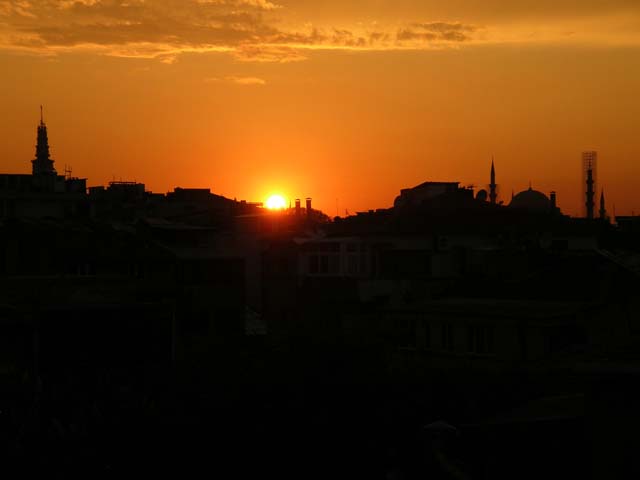
Istanbul at sunset
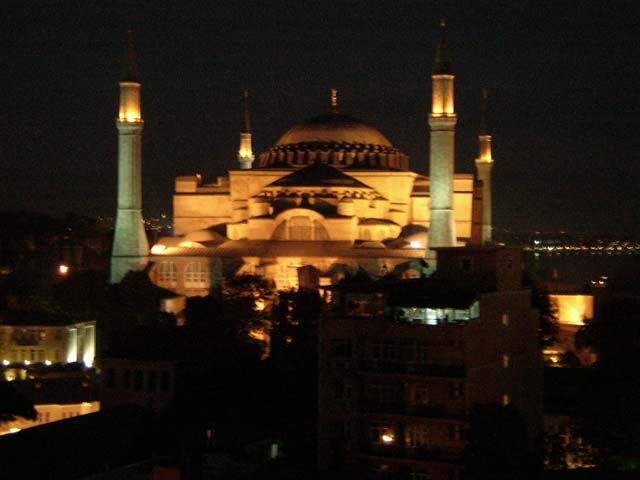
Hagia Sophia lit up at night
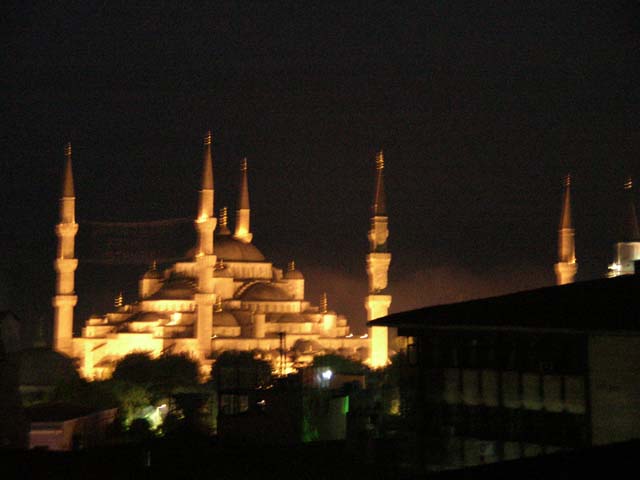
The Blue Mosque, Ahmed Sultan Mosque, at night - takes its name from the extensive blue tile work inside.
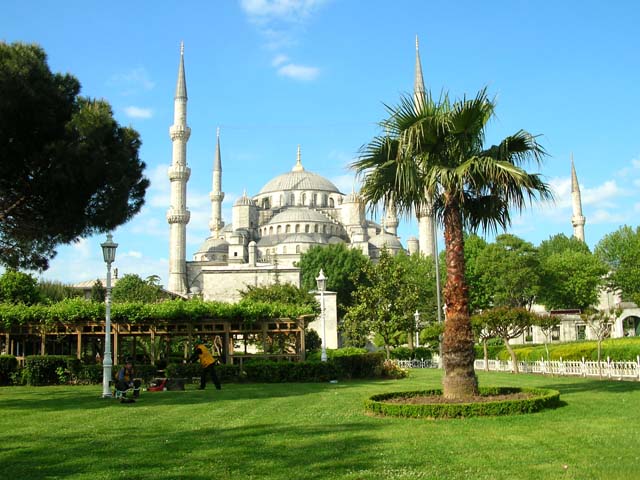
Blue Mosque in the daytime.
The Blue Mosque was commissioned by Sultan Ahmet I as a rival
to Hagia Sophia and designed by famous architect Mehmet Aga. Construction began in 1609 and took seven years.
The original six minarets caused quite a scandal, as the Haram Mosque in Mecca (the holiest in the world)
also had six minarets. In the end, the problem was solved by adding a seventh minaret to Mecca's mosque.
The other striking feature of the exterior is the beautifully arranged cascade of domes
that seem to spill down from the great central dome.
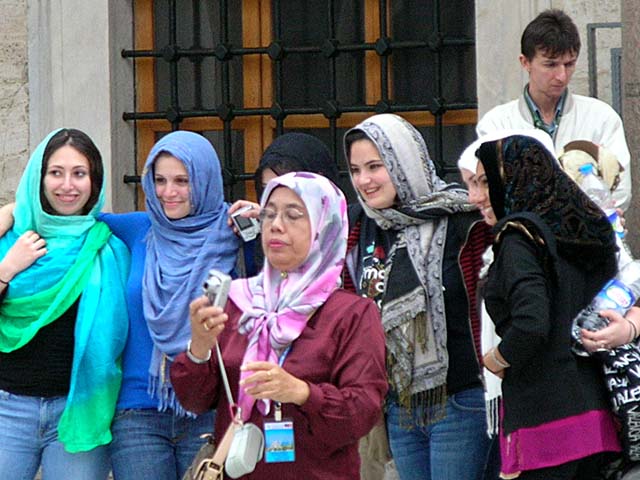
Like people do everywhere, Turkish citizens taking a group photo to commemorate their visit to a famous
spot, the Blue Mosque. Jeans are popular in Turkey, too.
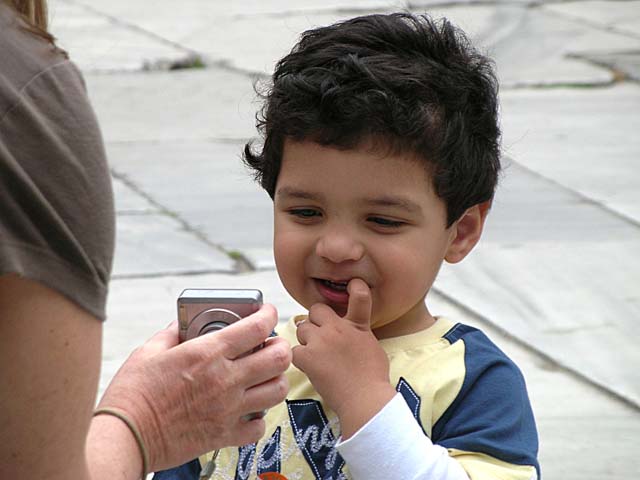
A fascinated child looks at his photo that has just been taken by a Western tourist.
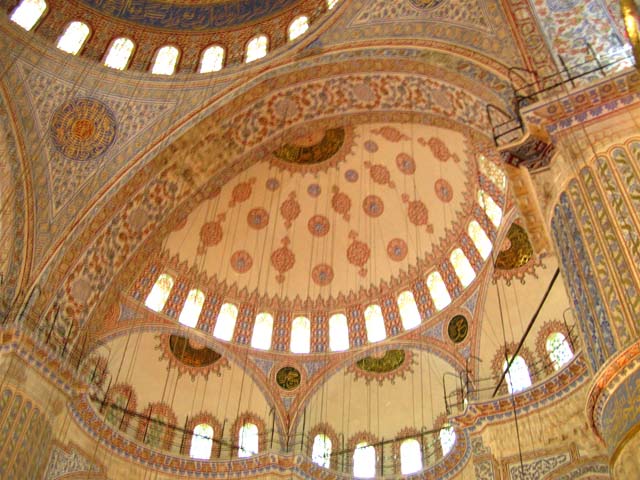
Part of the main dome of the Blue Mosque
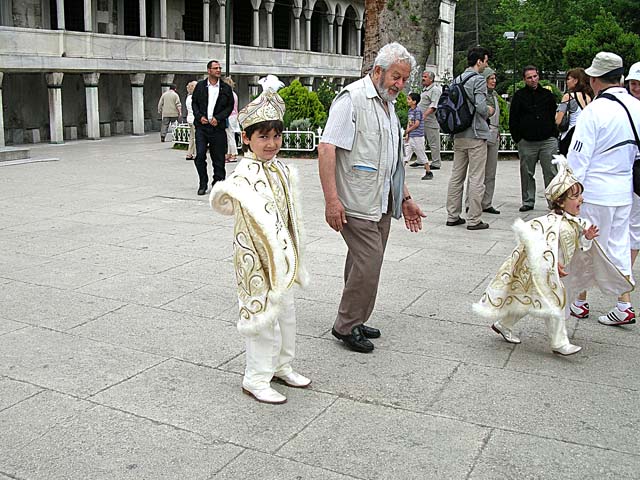
For the celebration of his circumcision ritual, a boy is dressed in the satin uniform of a sergeant major.
His parents
throw a lavish celebration. In line with Islamic tradition, Turkish boys are often circumcised
between the ages of 7 and 10.
Link to Page Two
Link to Page 6 - Start of Cappadocia region photos
Pat's Home Page